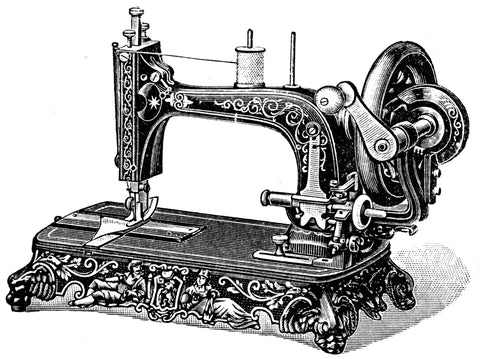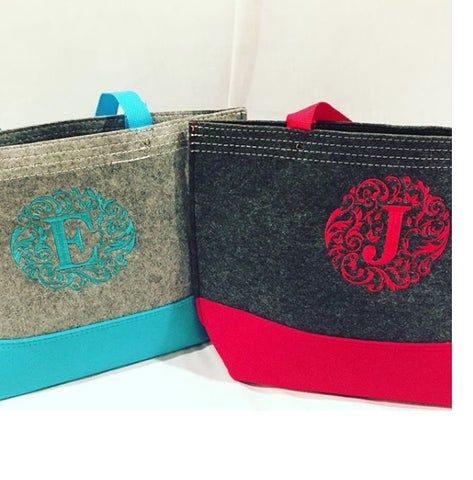
How to Embroider Letters on Canvas Tote Bags
You don’t want just any ordinary tote bag. You want a tote that’s all your own — a bag that not even your friends or fellow fashionistas have.
With the help of creative personalization tools, you can create tote bags ideal for school, shopping, traveling abroad, gifts, business, and even nights out on the town.
There are different personalization methods out there. Out of them all, embroidery has stood the test of time. This timeless technique is still used to personalize everything from accessories to home decor.
Learn more about this special technique and how to embroider letters on your canvas tote bags!
What is Embroidery?
Embroidery is one of history’s oldest fabric design techniques. The earliest forms of embroidery are traced back to 30,000 BCE! Even the mythical Greek Goddess herself, Athena, has been “credited” with introducing embroidery to the western world!
Embroidery exists in most cultures and countries across the globe, including India, Japan, Russia, France, and medieval England.
Types of Embroidery Stitching
The foundation of embroidery is simple — it’s the art of stitching thread onto fabric.
Typical embroidery stitches include:
- The classic back-stitch
- Cross-stitching
- Running stitch
- Simple straight stitch
- Stem stitching for outlines
- French knots
- Satin stitch
- Chain stitching
- Feather stitch
- Split stitching
- Woven wheels
- Crouching stitch
Other types of embroidery stitches include blanket stitches, fly stitching, and bullion knots for making roses!
Early embroidery was completed by hand. However, the first hand-powered embroidery machine was created in the 19th-century. The classic embroidery hoop was invented in 1903, which allowed artisans to complete more intricate, sophisticated designs.
Early embroidery machines and hoops paved the way for digital embroidery decades later. 1980 introduced the first computerized embroidery machine, which created a new world of possibilities for design. Today’s digital embroidery machines are faster and more accurate than ever.
Ready to try it for yourself?
Follow these steps to embroider your own canvas tote!

1. Brainstorm Your Embroidery Design
Embroidery requires hundreds and thousands of different stitches. That’s a lot of work!
Don’t “wing” your lettering from the start. The last thing you want to do is pull out all your stitches if you’re unhappy with your design. Brainstorm several ideas first before embroidering your tote bags.
If this is your first typography design, start with something simple. Plants, flowers, letters, and classic motifs are excellent embroidery subjects for beginners.
2. Create Your Design
Embroidery is like drawing. Instead of pen and paper, you’re using thread and fabric.
Draw out your design on a piece of paper. You could also use tracing paper to outline motifs and transfer them onto drawing paper. You’ll also find plenty of lettering patterns online for inspiration.
Don’t forget about the sizing. Design lettering that’s proportionate for your bag.
Once you’re done with the drawing, cover your illustration with tracing paper to create an outline. Don’t worry about outlining every little detail, like light, shading, and shadows. You’re going to fill in those details with colorful embroidery thread.
Make sure to use a pencil during this process so you can fix your mistakes along the way. Take your time with this step. Do your best to make your design as exact as possible.
Once you start stitching, it’s harder to fix mistakes. Pulling out stitches can pull and loosen your tote bag fabric if you’re not careful.
If you decide to use a digital embroidery service or a machine, you could bypass the design process if you already have a font or saved art file you want to use. All you have to do is provide the printing professional with your file.
If you’re using a digital embroidery machine, you will upload your design into your program of choice.
3. Transfer Your Design Onto Your Canvas Tote Bags
After outlining your design, transfer your outline to water-soluble embroidery paper. This type of paper has a sticky adhesive backing which keeps your design in-place on heavy canvas tote bags.
If you’re using a digital embroidery service, you won’t have to worry about soluble paper because this step is covered for you!
If you’re embroidering your totes yourself, you can either draw the design directly onto your water-soluble paper or use a printer. Most quality printers should be able to print on this type of paper. Use a printer if you’re worried about accuracy.
Water-soluble embroidery paper can be used on most fabric surfaces, from large canvas tote bags to thinner fabric purses.
Next, trim any excess paper around your design. The less paper you have to deal with, the better. Leave no more than an inch of paper around your design.
Don’t stick your design onto your tote just yet. Take your time to find the right placement for your design.
When you’re ready, gently pull off the backing and place your design on the surface of your tote. Gently press down on the water-soluble paper and smooth it over with a ruler. You don’t want any air bubbles!
4. Practice Your Embroidery Stitching
You’re almost ready to stitch your beautiful lettering onto your bag, but remember, practice makes perfect.
If you’re using a professional embroidery service, you can skip this step. However, it doesn’t hurt to learn how to embroider beforehand. The more you know, the easier it is to communicate what you want.
Research the stitches you need to execute your design before you stitch. Once you start sewing, it’s full steam ahead. It’s a lot harder to fix your mistakes, and pulling out stitches can leave holes in your fabric.
Brainstorm stitches just like you did with your design. For example, if you’re embroidering garden inspired letters, you’ll want to include stem stitches and knots.
Just like paints and markers, embroidery thread comes in a rainbow of vibrant colors. Choose your colors carefully. Use a color wheel to find the best color combinations for your creative project.
Take your time with this, especially if you’re new to embroidery. Practice on a few canvas scraps first. You should also take some time to practice every embroidery stitch.
If you’re using a digital embroidery machine at home, stitch a few samples to get a feel for your sewing device. Your computer may have a few hiccups that you’ll need to work out first.
You can also watch a youtube video on How to Embroider a Tote Bag on a Single Needle Embroidery Machine here!
5. Time to Stitch!
Now for the fun part! It’s time to sew your design onto your canvas bag.
Make sure your design is stuck firmly in place. You don’t want your water-soluble paper wiggling around during the stitching process.
If you do need to move your design, gently pull off the paper without stretching the fabric. High-quality embroidery paper should be removable. Watch out for any sticky residue!
If you’re stitching by hand, place your embroidery hoop around your design. Choose a hoop that’s big enough for your design. For best results, leave a 2 to 5 inches of room around your drawing.
Tighten your hoop and fabric until you have a nice and tight surface to work with. This part is so important. Tight material is essential for achieving detailed embroidery.
Make sure to use an embroidery needle only. Embroidery needles have longer eyes and sharper points than regular sewing needles. You need a needle that easily pierces through your water-soluble paper and canvas fabric without too much resistance.
You also need embroidery thread specifically, not the regular thread for sewing. This thread is not thick yarn or string. Embroidery thread is thin, and you’ll need to separate the strands first.
The more embroidery stands you use, the thicker your letters will be. Remember this as you brainstorm your designs and stitches as well.
After threading your needle, create a small knot at the bottom. This knot will keep your thread in place as you stitch.
If you’re using a service, embroidery and printing professionals will take care of this step for you.
If you’re using an at-home embroidery machine, make sure to upload your design correctly and program the right stitches for the project. Your digital embroidery machine will sync up with your computer so that you can see your progress on the screen.
Carefully stitch along your design. Do your best to stitch directly onto your outline. That’s why you need a special embroidery needle.
6. Wrapping Up Your Embroidery Design
You’re almost done with your first embroidery project!
Secure your last stitch with a sturdy knot on the back of your design. Your completed letters should look like a colorful, stitched illustration.
Your final step is to soak your canvas tote bags in warm water. This step will dissolve the water-soluble embroidery paper, leaving a beautiful design.
Let your tote air dry before throwing it in the washing machine. Once your tote is dry, iron out any leftover wrinkles on your bag.
Now you can enjoy a beautiful and unique canvas tote bag that’s totally unique to you!
Show off your new tote bag at the grocery store or local farmer’s market. Embroider more totes for your family and friends. Once you start embroidering, you’ll be hooked.
Personalize Your Canvas Tote Bags Your Way
Your style is all your own. Why settle for just any tote on the rack? Use this guide to create unique and personalized canvas tote bags for you, your friends, and even future customers.
Need more inspiration for your personalized accessories? Check out our blog to stay updated on the latest tips and trends, or personalize your bags right away!
People also want to know
How do you attach needlepoint to a bag?
Using the hot glue glue a side of the needlepoint and put it into place. Once the needlepoint is on the bag, you will need to shoot the glue between the bag and the needlepoint. I find this works best if I lay the bag flat on the table. You may need to touch up the glue in spots to get a good seal.
Can you machine embroider on canvas?
Yes! Stretched canvas is a really good material to machine embroider on. It has a smooth, tight surface, and the fabric has already been stretched.
What is waste canvas cross stitch?
Waste Canvas is a stiff canvas that is held together with water-soluble glue. Once the fibers become wet, the strands can easily be pulled out, leaving only your stitching on the fabric. It is typically sold in fabric counts of 6.5, 8.5, 10, 12, and 14 stitches per inch.
Ten articles before and after
The world in numbers
| Professional Bag Manufacturer
How your child learns the foreign language of mathematics
| Professional Bag Manufacturer
8 Reasons for Why You Should Purchase a Clear Bag | Professional Bag Manufacturer
The easy way for your children to learn to tell the time
| Professional Bag Manufacturer
Guide to DIY Screen Printing on Tote Bags at Home | Professional Bag Manufacturer
Yeah! ergobag receives the Brand Award 2015 as “Best New Brand”!
| Professional Bag Manufacturer
Four ideas for “outdoor adventures”
| Professional Bag Manufacturer
Why early childhood learning is so important
| Professional Bag Manufacturer




 Mobile/What's App/Wechat
Mobile/What's App/Wechat E-Mail
E-Mail ADD
ADD




